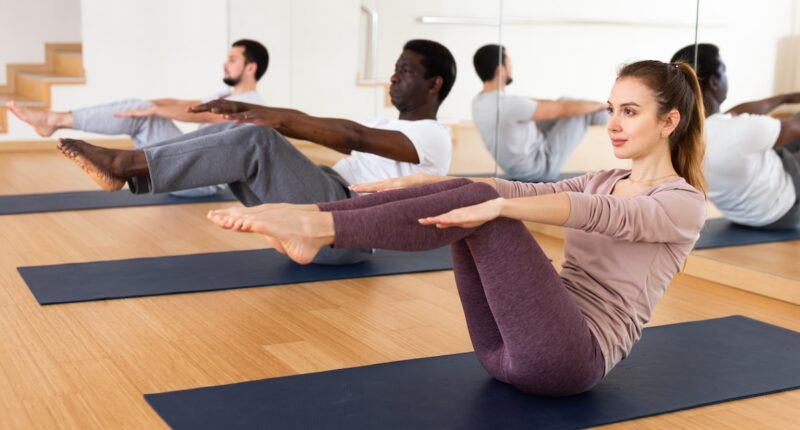Indulging in a luxurious meal can be a wonderful way to pamper yourself, spend time with loved ones, nourish your body, or all of the above. However, following a satisfying meal, you might experience discomfort such as bloating, gas, feeling overly full, or tiredness. Engaging in high-intensity exercises like running or HIIT may not be the most appealing option to help ease these stomach issues.
Pilates comes to the rescue. Originally designed as a practice focusing on breath control, fluid movements, and concentration, Pilates includes exercises that can aid in digestion by keeping our gastrointestinal (GI) system alert and prepared to process food efficiently. Below, we discuss how Pilates can improve your digestive health and suggest six effective moves you can try at home.
What’s the connection between Pilates and better digestion?
According to Becca Revier, a Pilates instructor at Life Time in Lakeville, Minnesota, “Pilates is a gentle exercise method that emphasizes strengthening the core and enhancing overall body strength, flexibility, and stamina by targeting the deepest core muscles known as the transverse abdominis. This, in turn, stimulates the intestines, leading to better digestion.”
Additionally, Revier says breathing is a key part of any good Pilates practice. The various breathing techniques in Pilates are aimed at helping to calm the mind and assist with proper movement form. As a result, this may decrease your cortisol (the “stress hormone”) levels; spending extended periods with high cortisol levels can impact hunger cues and the ability to get a good night’s sleep, both of which can affect digestion, per the Cleveland Clinic.
In fact, one small 2014 study1 published in the Journal of Exercise Nutrition & Biochemistry suggests a regular Pilates practice can boost metabolism and “good” cholesterol, which can have positive affects on digestion and overall health. A small 2022 controlled clinical trial2 in Clinical and Experimental Hypertension found that doing Pilates regularly can reduce blood pressure
Blood pressure in a healthy range is often associated with better digestion, per Harvard Health Publishing, because the body diverts extra blood to the GI tract after eating to assist with digestion. If your blood pressure is too high or too low, you can experience dizziness, nausea, and other negative symptoms during digestion.
6 Pilates moves to help with digestion
1. The hundred
The Pilates hundred gets your body warmed up and ready for the rest of these Pilates moves or for another workout. The arm pumping and breathing stimulates your body’s circulation. Curling up using your abdominal muscles also helps stimulate your digestive organs.
- Lie flat on your back with knees bent and feet flat together on the floor.
- Extend your arms up to the ceiling at shoulder height with your palms facing down.
- Keeping your legs glued together, use your core to lift your legs into a tabletop position, with your feet off the mat, knees over ankles, and ankles in line with knees at a 90-degree angle.
- Curl your head, neck, and chest up into a “crunch” position while reaching your arms toward your legs and extending your legs long on a diagonal line, about 45 degrees. If your lower back feels strained, lift your legs a little higher, bringing them back to a tabletop position, or lowering them to the floor.
- Keeping your wrists and fingers straight, start pumping the arms up and down in rapid, short movements while inhaling for five counts and exhaling for five counts.
- Repeat the breath pattern ten times to reach 100.
- Bend your knees back into a tabletop position as you rest your head, neck, and shoulders back on the floor. Or hug your knees into your chest for a restorative stretch.
2. Standing roll down
The rolling down motion helps relieve back tension, while engaging your abdominals helps stretch the digestive tract.
- Standing against a wall with your feet hip-width apart and your arms extended out in front of you.
- Peel your spine off the wall, bone by bone, until you reach the top of your pelvis.
- Slowly roll your spine back up, bone by bone, to the starting position.
- Repeat for desired number of reps.
3. Knee stirs
Circling your legs helps engage your lower abdominals to enhance circulation in your digestive organs.
- Lie flat on your back with your knees bent and feet flat on the floor. Extend your arms down by your sides.
- Bring your right knee into your chest.
- From your right hip, circle your right leg 3 to 5 times in one direction. Then reverse, circling your leg 3 to 5 times in the other direction. Your pelvis shouldn’t move; pretend you’re balancing a water glass on your stomach.
- Place your right foot back on the floor, then switch legs.
- Repeat for desired number of reps.
4. Single-leg stretch
Hugging your knee straight into your chest moves your body in the path of the digestive tract.
- Lie flat on your back with your legs extended. Extend your arms down by your sides.
- Lift your head, neck, and shoulders, and both feet off the ground a few inches.
- Keeping your left leg extended, bring your right knee into your chest.
- Then, extend your right knee and bring your left knee into your chest.
- Continue alternating for desired number of reps.
5. Saw
The twisting of this move wrings out your organs, while curling forward helps massage them.
- In a seated position, extend your legs wider than shoulder-width apart. If you have a tight back or legs, bend your knees to where it’s comfortable.
- Extend your arms out to the sides like airplane wings.
- Twist your torso to the left, then fold forward to reach your your right hand to your left pinky toe.
- Lift your torso back to the starting position.
- Twist your torso to the right, then fold forward to reach your your left hand to your right pinky toe.
- Repeat for desired number of reps.
6. Rolling like a ball
Rolling massages your spine, which, in turn, massages your internal organs.
- Sit on the floor and hug your knees to your chest.
- Roll backward to your shoulder blades.
- Then, roll back up to the starting position, keeping your knees tucked into your chest the entire time.
- Repeat for desired number of reps.





